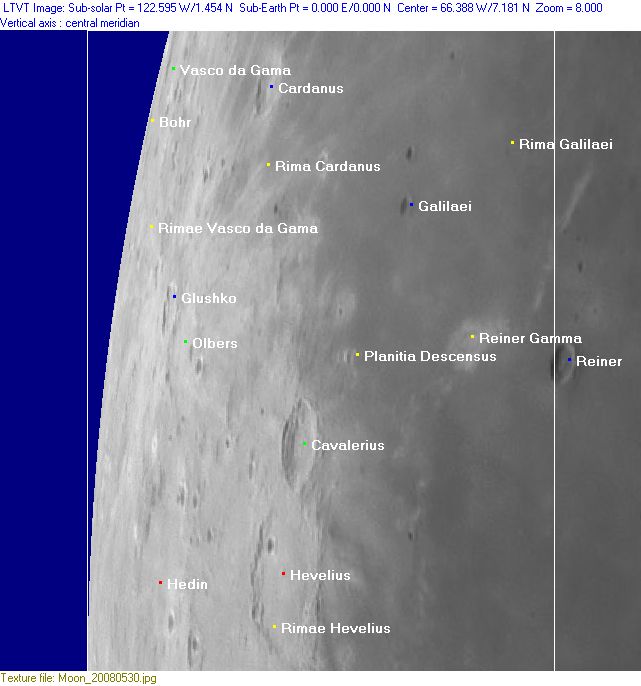Rükl 28
Contents
Rükl Zone 28 - GALILAEI
Neighboring maps on the Rükl Nearside Map:
| 28 |
||
Photographic Map
(This map is based on an Earth-based photograph that has been computer-corrected to zero libration. The vertical white lines indicate the left and right boundaries of the Rükl rectangle)
Background image source
Nearside Named Features
- Africae pars (J.Hewelcke's disallowed name for the far western highlands, north-northwest of Grimaldi).
- Baum (a disallowed name from H.P.Wilkins for Sven Hedin E, or perhaps for Sven Hedin F).
- Bohr
- Buss (a disallowed name from H.P.Wilkins for a crater west of Hedin).
- Cardanus
- Cavalerius
- Curious elongated rugby-ball shaped craterlet north-northwest of Reiner Gamma (LAT: 9.00 / LON: -59.61). See http://bit.ly/2xYJxme
- Dorsa Reiner R (an unofficial name from D.Caes for the circle shaped system of wrinkle ridges south of Reiner, officially known as Reiner R).
- Dorsum Galilaei (an unofficial name from D.Caes for the wrinkle ridge which runs south and west of Galilaei).
- Dorsum Hermann B, Dorsum Hermann H, Dorsum Hermann K, and Dorsum Hermann L (four unofficial names from D.Caes for four wrinkle ridges north and northwest of Hermann) (see chart 39).
- Dorsum Hevelius D (an unofficial name from D.Caes for the wrinkle ridge which runs north-south through the bowl-shaped crater Hevelius D).
- Eccentric crater (a nickname from D.Caes for the eccentric crater in Hermann A, see close-up in the LROC's Act-React Quick Map) (Hermann A's location is just north of the lunar equator, Hermann itself is located just south of it, see Chart 39) (perhaps Hermann A is the same kind of formation as Bonpland D on Chart 42).
- Galilaei
- Glushko (centre of impressive ejecta ray system).
- Hedin (and farside raycrater Pierazzo west of it, of which the easternmost part of its ejectablanket might be observable during very favorable libration!).
- Hevelius (J.Hewelcke's Mons Pherme).
- Ingalls (a disallowed name from H.P.Wilkins for Riccioli C, north of Riccioli itself).
- Littus Eclipticum (Riccioli's discontinued name for the limb region west-northwest of Cardanus).
- Luna 8 (crash-landed on December 6, 1965, south of Galilaei).
- Luna 9 (soft-landed on February 3, 1966, at Planitia Descensus).
- Mons Thambes (J.Hewelcke's disallowed name for a vague bright area northeast of Hermann) (for crater Hermann, see Chart 39).
- Oceanus Procellarum (Van Langren's Oceanus Philippicus) (the western part of it, occupying the right half of Chart 28).
- Olbers
- Planitia Descensus (the landing site of Luna 9; mankind's first soft-landed object on the moon).
- Reiner Gamma (called the Jew's Harp by Elger, Bullialdi by Van Langren, Mons Audus by J.Hewelcke).
- Rima Cardanus
- Rima Galilaei
- Rimae Hevelius
- Rimae Vasco da Gama
- Sundman V (the high-albedo crater Sundman V at 12°North/ 93°West seems to be the final resting place of the remains of lunar probe LADEE (impact on April 18, 2014). During favorable libration of the moon's western limb it is possible to observe this high-albedo crater).
- Terra Caloris (Riccioli's discontinued name for the region west of Oceanus Procellarum).
- Terra Iustitiae (Van Langren's disallowed name for the region west of Oceanus Procellarum).
- Vallis Bohr
- Vasco da Gama
Note: one of the disallowed names from H.P.Wilkins was Bolton, which seems to be a crater somewhere at the western limb regions. The location of Bolton could also be somewhere on Chart 39, south of Chart 28. - DannyCaes Oct 18, 2015
Farside Named Features
(The following features are not formally included in the present Rükl rectangle, but they are adjacent to it and their centers are less than 10° beyond the mean limb -- so they may be seen here in whole or in part with a favorable libration)
- Mees
- Pierazzo (small bowl-shaped crater with extremely beautiful system of rays around it) (for telescopic observers of the moon the eastern part of this high-albedo system of rays is perhaps visible during very favorable libration, west of crater Hedin).
- Sundman
- Strange to say, the lightblue colored lunar farside map in Patrick Moore's Spectrum Atlas of the Universe (1970) shows the names Fermi and Planck at the western libration zone, at about 90 degrees West, 9 degrees North).
Lettered Crater Locations
(click on the thumbnails to display full-sized images; use browser BACK button to return - the dashed white lines are the midpoints of the Rükl zones)
Full zone with lettered craters:
Lettered craters by quadrants:
| North West |
North East |
| South West |
South East |
Additional Information
- Other online descriptions of features in this Rükl map section:





